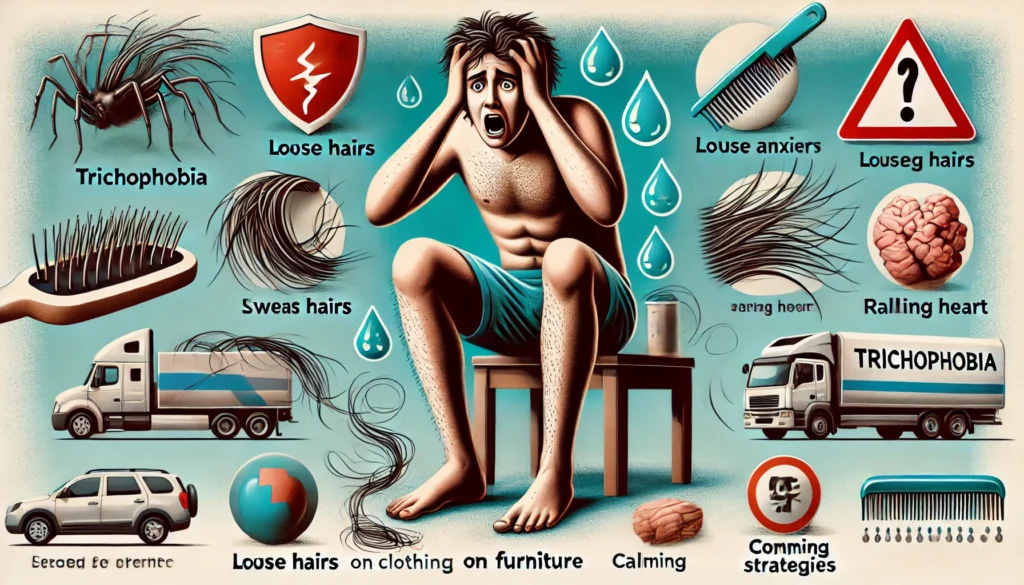Understanding Trichophobia: The Fear of Hair
Trichophobia, or the fear of hair, is a specific phobia that can manifest as an irrational and excessive fear of hair. People who suffer from this condition may experience intense anxiety at the sight of loose hairs on clothing, furniture, or the floor. This fear can extend to their body hair as well as the hair of others. The origins of trichophobia are varied and can stem from past traumatic experiences or associative learning. Understanding this condition is vital for both sufferers and their loved ones to manage its effects effectively.

Causes and Symptoms of Trichophobia
Trichophobia, like many specific phobias, often develops early in life. It may begin with a negative experience involving hair, such as a traumatic haircut, or can be linked to other fears, such as those related to cleanliness or germs. Psychological theories suggest that phobias like trichophobia are often caused by both environmental and genetic factors. For instance, a person might inherit a tendency toward anxiety, which can manifest as specific phobias under certain conditions.
Symptoms of trichophobia vary widely but generally include severe anxiety or panic attacks at the sight or thought of hair. This can lead to avoidance behaviors, where the individual goes to great lengths to avoid encountering loose hair. Physiological symptoms may include sweating, rapid heartbeat, nausea, or dizziness when confronted with the phobic stimulus. Emotional distress is also common, particularly if avoidance disrupts daily routines or interpersonal relationships.
Understanding the symptoms is vital for diagnosis, as many phobias can mimic or coincide with other anxiety disorders. For trichophobia, the specific trigger is hair, which is a distinctive aspect in diagnosing and differentiating it from other conditions. Awareness of these symptoms not only helps in seeking appropriate help but also in gaining empathy and support from friends and family.
The impact of trichophobia can extend to social interactions and personal hygiene. Some individuals may avoid social situations where loose hair may be present, such as beauty salons, or even personal grooming activities that involve hair. This can lead to significant distress and lifestyle limitations, highlighting the need for effective treatment strategies.
In children, trichophobia can manifest as fear or tantrums during haircuts, bathing, or while brushing hair. Recognizing these signs early can help in managing the phobia before it becomes more ingrained. Early intervention can reduce the intensity of the phobia as the child grows, offering a better prognosis compared to addressing it in adulthood.
Diagnosis and Treatment Options
Diagnosing trichophobia involves a comprehensive evaluation by a mental health professional. This typically includes a detailed interview and may utilize specific psychological assessments to rule out other conditions. Diagnoses are based on the criteria outlined in the Diagnostic and Statistical Manual of Mental Disorders (DSM-5), which includes an excessive and irrational fear triggered by the presence or anticipation of a specific object or situation—hair, in this case.
Treatment for trichophobia is varied and can be tailored to the severity and specific needs of the individual. Cognitive-behavioral therapy (CBT) is one of the most effective treatments. It involves exposure to the fear in a controlled and gradual manner, combined with strategies to manage anxiety and change negative thought patterns associated with hair.
In some cases, medication may be prescribed to help manage the symptoms of anxiety and panic attacks associated with trichophobia. These might include antidepressants or anti-anxiety medications, which can help make CBT more effective. It’s important to note that medication is generally seen as a short-term solution or as a support for other therapy forms.
Support groups and online forums can also provide valuable resources and communal support for individuals dealing with trichophobia. Sharing experiences and coping strategies can help lessen the feeling of isolation that often accompanies phobias. Platforms like Lumende can be particularly helpful in connecting individuals with therapists who specialize in treating specific phobias.
Relaxation techniques such as deep breathing, meditation, or yoga can also be beneficial in managing the physiological symptoms of trichophobia. Incorporating these practices into daily routines can help reduce overall anxiety levels and improve the effectiveness of more targeted phobia treatments.
Coping Strategies and Support Systems
Developing effective coping strategies is crucial for managing trichophobia in the long term. One of the first steps is for the individual to educate themselves about their phobia. Understanding that phobias are a treatable anxiety disorder can reduce feelings of shame or isolation.
Creating a support system is also vital. This can include family, friends, and mental health professionals who understand the condition and can provide emotional and practical support. For instance, family members can help by maintaining a living environment that minimizes the presence of loose hair, reducing potential stress for the phobia sufferer.
Behavioral strategies, such as setting small, manageable exposure goals, can also be helpful. These should be designed with the help of a therapist to ensure they are challenging yet achievable, providing a sense of control and accomplishment as the individual works through their fear.
Journaling or maintaining a diary can be a therapeutic tool for individuals to express their feelings and track their progress. Writing about encounters with the phobic stimulus can help desensitize the individual to hair and provide valuable insights into the patterns of their anxiety.
Lastly, regular follow-ups with mental health professionals ensure that the treatment remains effective and is adjusted according to the individual’s progress. This continuous engagement with therapeutic resources plays a crucial role in recovery and in managing setbacks that may occur.
For those struggling with trichophobia or any specific phobia, Lumende provides a platform to find qualified therapists who specialize in anxiety disorders. Access to the right resources and expert care can significantly improve the quality of life for those affected by this condition.

 English
English
 Deutsch
Deutsch Français
Français